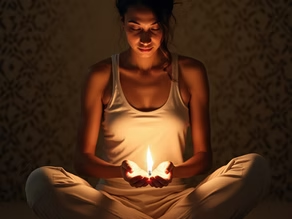
Just as the roots anchor a tree firmly to the ground, Pratyahara anchors the practice of yoga by fostering a deep connection to one’s inner self. As the fifth limb of Patanjali’s Eight Limbs of Yoga, it involves the withdrawal of the senses from external distractions, allowing practitioners to redirect their focus inward. He, she, or they can explore Pratyahara to cultivate mindfulness, enhance concentration, and foster emotional balance, ultimately serving as a transformative bridge to deeper meditation and self-awareness.
Key Takeaways:
- Pratyahara is the practice of withdrawing the senses from external stimuli to turn attention inward, fostering a deeper connection with the inner self.
- The term Pratyahara is derived from Sanskrit, meaning “withdrawal from that which nourishes the senses,” highlighting the shift from external distractions to internal awareness.
- This practice serves as a bridge between external yoga practices and internal meditation, helping cultivate concentration, emotional balance, and deeper meditative states.
Understanding Pratyahara
To fully appreciate the essence of Pratyahara, it is important to recognize its place within Patanjali’s Eight Limbs of Yoga. Pratyahara, which stands as the fifth limb, marks a significant transition from the external practices of yoga, such as asana and pranayama, to more internalized practices like concentration and meditation. By withdrawing from sensory distractions, practitioners can create a conduit to a deeper understanding of their inner selves, fostering a richer connection with their true essence.
Definition and Origins
Along with its grounding in Sanskrit, the term “Pratyahara” is formed from two roots: “prati,” meaning “against” or “away,” and “ahara,” which translates to “nourishment” or “food.” This etymology provides insight into the practice, emphasizing the intention of withdrawing from external sensory influences that typically nourish the senses. Pratyahara represents a conscious effort to redirect attention inward, allowing individuals to explore their inner thoughts and feelings akin to a journey towards self-discovery.
The Meaning of Sensory Withdrawal
Among the fascinating aspects of Pratyahara is its emphasis on sensory withdrawal, a technique that empowers participants to disengage from the external world. Through this practice, individuals learn to observe their sensory experiences without attachment, fostering a sense of detachment from distractions that can cloud their mental clarity. This withdrawal isn’t merely about shutting out external stimuli; rather, it encourages a reflective state that promotes deeper introspection and self-awareness.
At the core of sensory withdrawal lies the potential for profound transformation. By consciously disengaging from external stimuli, practitioners can uncover layers of their psyche previously masked by daily distractions. This inward focus allows them to deepen their emotional resilience and cultivate an enhanced capacity for meditation, ultimately leading to enriched spiritual insights and a greater understanding of their interconnectedness with the universe.
The Importance of Pratyahara
It is necessary to recognize the significance of Pratyahara in the broader context of yoga practice. This fifth limb serves as a vital link between the external practices, such as asana and pranayama, and the internal disciplines of concentration and meditation. By learning to withdraw from the distractions of the outside world, practitioners can achieve a profound level of inner awareness and peace. For those interested in delving deeper into this transformative practice, they may refer to How to Practice Pratyahara: A Guide to the Fifth Limb of Yoga to explore various techniques and insights.
Connection to the Eight Limbs of Yoga
Yoga is an intricate system, comprising eight interconnected limbs outlined by Patanjali. Each limb builds upon the previous one, with Pratyahara playing a pivotal role in this progression. After establishing a foundation through ethical practices and physical postures, retreating inward allows the practitioner to transition smoothly into concentration and meditation. This withdrawal enhances one’s capacity to focus, enabling deeper exploration of the mind and spirit.
Creating Inner Stillness
Pratyahara facilitates the cultivation of inner stillness by helping individuals detach from sensory distractions. Through the practice of withdrawing the senses, they can create a serene mental landscape that fosters reflection and insight. This stillness is not merely the absence of noise or movement but a profound state of awareness where the mind can settle, free from the incessant chatter of daily life.
Hence, as practitioners engage in the practice of Pratyahara, they often discover that true stillness arises within, creating a sanctuary for introspection and fostering emotional balance. This inner quietude is instrumental in enhancing their capacity for deeper meditation, which ultimately leads to greater self-awareness and connectedness with the essence of their being.
Practical Techniques for Pratyahara
Many practitioners of yoga find that integrating practical techniques for Pratyahara into their routine can significantly enhance their overall experience of the practice. These techniques serve as effective tools for achieving sensory withdrawal, allowing individuals to begin on an inward journey toward deeper self-awareness and mindfulness. By employing exercises focused on sense withdrawal and breath awareness, they can cultivate a more profound connection with their inner selves, ultimately leading to enhanced meditation and emotional balance.
Sense Withdrawal Exercises
To begin sense withdrawal exercises, one effective method involves creating a serene environment free from distractions. Practitioners can close their eyes and bring awareness to each sense—sight, sound, smell, taste, and touch—acknowledging the present stimuli without clinging to them. Gradually, they can visualize drawing these senses inward, transitioning focus away from external inputs towards the sensations and thoughts arising within. This practice fosters an awareness of the self beyond external distractions, promoting a sense of quietude and introspection.
Breath Awareness Practices
Sense of breath is fundamental in guiding the inner focus during Pratyahara. Practitioners can utilize breath awareness as an anchor, observing the natural flow of inhalation and exhalation while consciously releasing external thoughts and distractions. By grounding their attention on the rhythm of the breath, individuals create a sense of calm and presence, allowing them to research deeper into their consciousness over time.
In addition, breath awareness practices can enhance emotional resilience and overall
psychological well-being. By concentrating on the breath, practitioners can foster a meditative state that facilitates insight into their emotional landscape. Breathing techniques such as deep abdominal breathing or rhythmic breathing can promote relaxation and help individuals detach from external influences, making way for a more profound connection with the inner self. Through consistent practice, they may uncover layers of their being that lead to greater peace and fulfillment in daily life.
Mindfulness and Pratyahara
Despite the challenges of modern life that often pull individuals’ attention in multiple directions, the practice of Pratyahara provides a vital pathway to mindfulness. By emphasizing the withdrawal of the senses, he or she can cultivate an environment conducive to introspection and heightened awareness. Pratyahara connects the physical practices of yoga with the deeper internal work of meditation, allowing practitioners to step back from external distractions and focus on their inner landscape. This conscious shift enables a renewed connection with one’s true self, fostering a space for genuine stillness and reflection.
Cultivating Present-Moment Awareness
With a foundation in breath awareness and sensory withdrawal, individuals will find that cultivating present-moment awareness becomes a transformative experience. By attending to the rhythm of their breath, they can anchor themselves in the present, letting go of the noise and chaos of the outside world. This focused attention leads to a greater appreciation and understanding of the sensations occurring within their bodies, paving the way for deeper insights and connections with their internal self.
Observing Thoughts and Emotions
Above all, the practice of Pratyahara enables individuals to observe their thoughts and emotions without becoming entangled in them. By adopting a non-judgmental approach, he or she can witness the fluctuations of the mind, allowing thoughts to arise and dissipate like passing clouds. This practice nurtures an attitude of detachment and equanimity, necessary for emotional balance and resilience. As they cultivate this ability to observe, they create a spaciousness within themselves that facilitates deeper meditation and insight.
Awareness of thoughts and emotions is paramount for achieving emotional balance. When practitioners engage in observing their mental patterns, they begin to recognize the transient nature of their feelings and thoughts. This observation allows them to detach from negative thought cycles and emotional reactions, fostering a sense of inner peace. By embracing the concept of witnessing their experiences without judgment, he or she can reclaim their power over their responses, ultimately leading to a more harmonious state of being.
Benefits of Practicing Pratyahara
All practitioners of yoga can find immense value in the practice of Pratyahara, particularly when it comes to enhancing concentration. By intentionally withdrawing the senses from the external environment, individuals create a mental space that allows for focused attention. This practice encourages he or she to navigate distractions effectively, fostering a deeper engagement with the task at hand. As they learn to detach from sensory stimuli, they may experience improved mental clarity and the ability to maintain sustained concentration during meditation or daily activities.
Enhanced Concentration
Benefits of cultivating enhanced concentration through Pratyahara extend beyond the yoga mat. Individuals often report increased productivity and better decision-making skills as a result of their ability to focus more profoundly. This strengthened capacity for concentration helps them remain immersed in activities, whether it involves studying, working, or engaging in creative pursuits. By fostering a state of inner calm, practitioners cultivate an environment conducive to focused work, ultimately leading to a more efficient and fulfilling experience in all areas of life.
Emotional Resilience
Beside enhancing concentration, Pratyahara also plays a significant role in building emotional resilience. He or she learns to observe thoughts and feelings without attachment, which cultivates a more balanced response to emotional fluctuations. This practice allows individuals to distance themselves from overwhelming emotional reactions, fostering greater inner peace and stability amidst daily challenges. By training the mind to navigate emotional currents with equanimity, practitioners can approach life’s ups and downs with a newfound sense of strength and confidence.
Concentration on one’s inner experiences through Pratyahara enables he or she to develop a profound understanding of their emotional landscape. As they engage in this introspective practice, individuals often gain insights into the origins of their feelings, allowing for constructive processing and healing. This grounded approach helps participants to build resilience over time, leading to a more profound emotional equilibrium that enriches their overall well-being.
Integrating Pratyahara into Daily Life
Once again, the practice of Pratyahara invites individuals to weave moments of introspection and sensory withdrawal into their everyday routines. By consciously disengaging from the overwhelming stimuli present in modern life, they can cultivate a deeper connection to their inner selves. This integration does not necessitate hours of dedicated practice; rather, small, deliberate actions throughout the day can create significant shifts in awareness and overall well-being. Whether they choose to take a few moments of quiet reflection during a busy day or engage in focused breath work, the opportunities for integrating Pratyahara are abundant.
Everyday Mindfulness
Life offers myriad opportunities for practicing mindfulness, enabling individuals to cultivate a sense of presence amid chaos. By intentionally withdrawing from external distractions, they are better equipped to navigate daily challenges with a calm and focused mindset. For instance, when commuting, they can turn their attention inward, observing their breath and releasing the tension accumulated from the day. Such moments serve as reminders that they have the power to control their attention and reactions, promoting a more centered lifestyle.
Developing Inner Peace
Below the surface of daily distractions lies an abundance of peace waiting to be accessed through the practice of Pratyahara. By withdrawing the senses and embracing inner stillness, individuals can cultivate a sanctuary of emotional balance and resilience. This development of inner peace allows them to face life’s challenges with greater equanimity, as they are no longer easily swayed by external circumstances. The act of observing thoughts and emotions without attachment fosters a profound sense of freedom, creating pathways to deeper meditation and spiritual insight.
With the consistent practice of Pratyahara, individuals may find that their minds become more adept at navigating life’s ups and downs, leading to a resilient inner state. They can experience a transformation in how they relate to themselves and their experiences, moving from reactivity to a more measured and reflective way of being. This alignment with their inner essence not only enhances their personal well-being but also fosters a greater sense of connectedness with those around them.
To Wrap Up
Taking this into account, Pratyahara emerges as a fundamental practice within the rich tapestry of yoga, enabling individuals to redirect their focus away from the external world and toward their inner selves. It emphasizes the importance of sensory withdrawal, allowing practitioners to gain clearer insight into their thoughts and emotions by creating a space free from external distractions. Through this inward journey, she cultivates a greater understanding of herself and her connection to the broader universe.
As they engage in Pratyahara, individuals find a pathway toward enhanced concentration, emotional stability, and an enriched meditation experience. This internal exploration fosters a deeper awareness of the self, ultimately illuminating the journey toward self-realization and inner peace. By integrating Pratyahara into their practice, practitioners can fully embrace the transformative power of yoga, unlocking the potential that lies within and recognizing the interconnectedness of all beings.
FAQ
Q: What is Pratyahara in the context of yoga?
A: Pratyahara is the fifth limb of Patanjali’s Eight Limbs of Yoga, which focuses on the practice of withdrawing the senses from external stimuli. The term is derived from Sanskrit, where “prati” means “against” or “away” and “ahara” means “nourishment.” Therefore, Pratyahara can be understood as the process of turning our attention inward, away from the distractions of the external world, to foster a deeper connection with our inner self and facilitate a smoother transition into concentration and meditation.
Q: How does Pratyahara benefit my yoga practice?
A: The practice of Pratyahara enhances various aspects of one’s yoga journey. By allowing ourselves to withdraw from external distractions, we cultivate a better ability to concentrate and focus during yoga practice. This withdrawal also promotes emotional stability by enabling us to observe our thoughts and feelings without getting overwhelmed by them. As such, it paves the way for deeper meditation experiences, where practitioners can access higher states of awareness and spiritual insight.
Q: What are some practical ways to engage in Pratyahara?
A: Engaging in Pratyahara can be approached through various practices. One effective method is sense withdrawal, which involves finding a quiet space, closing the eyes, and consciously directing attention away from sensory inputs. Another way is through breath awareness, using each inhale and exhale as an anchor to redirect focus inward. Mindfulness meditation is also beneficial; it encourages the observation of thoughts and emotions without judgment, fostering a sense of inner calm and spaciousness. Together, these practices cultivate a richer understanding of our inner selves.









